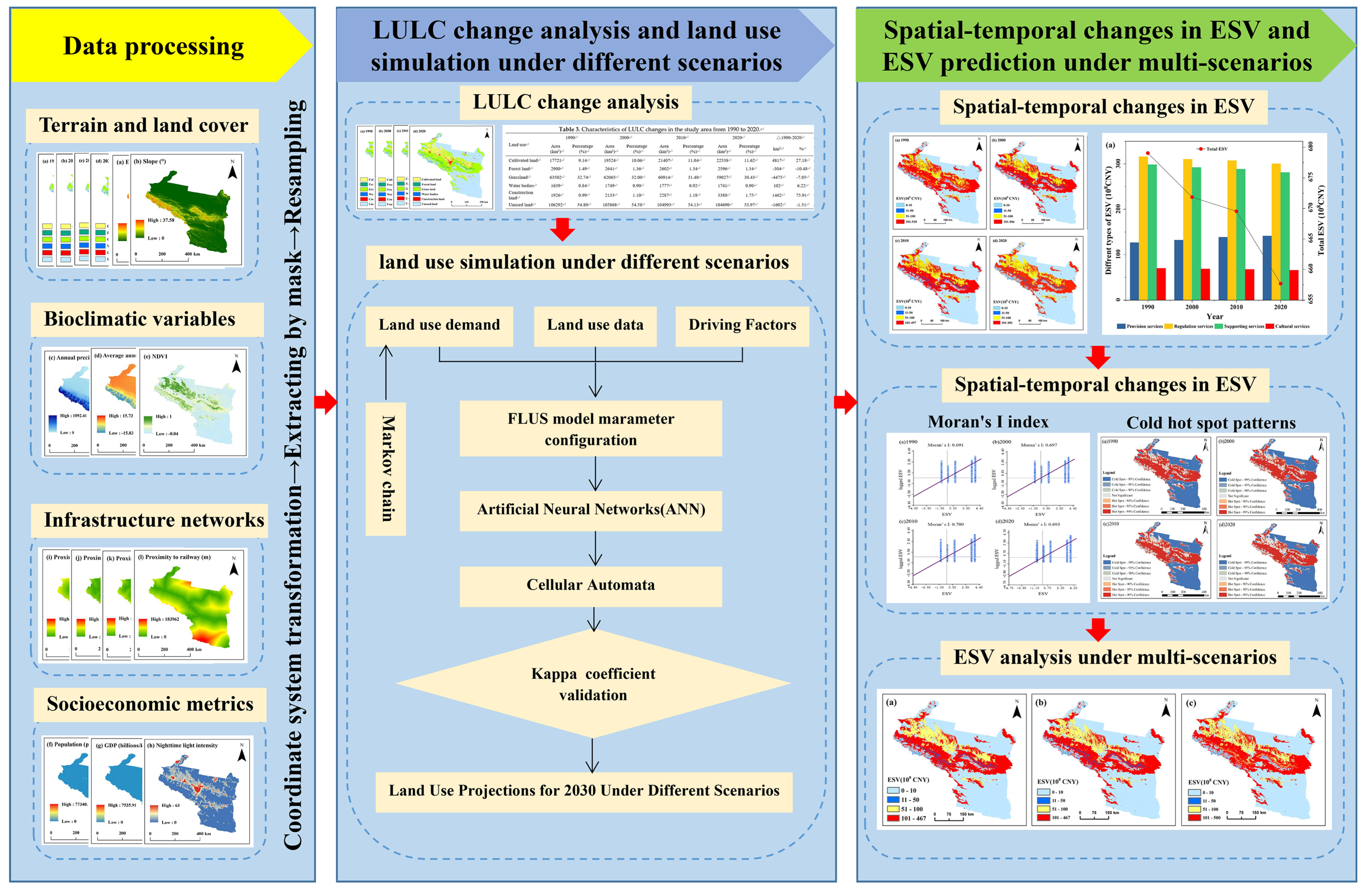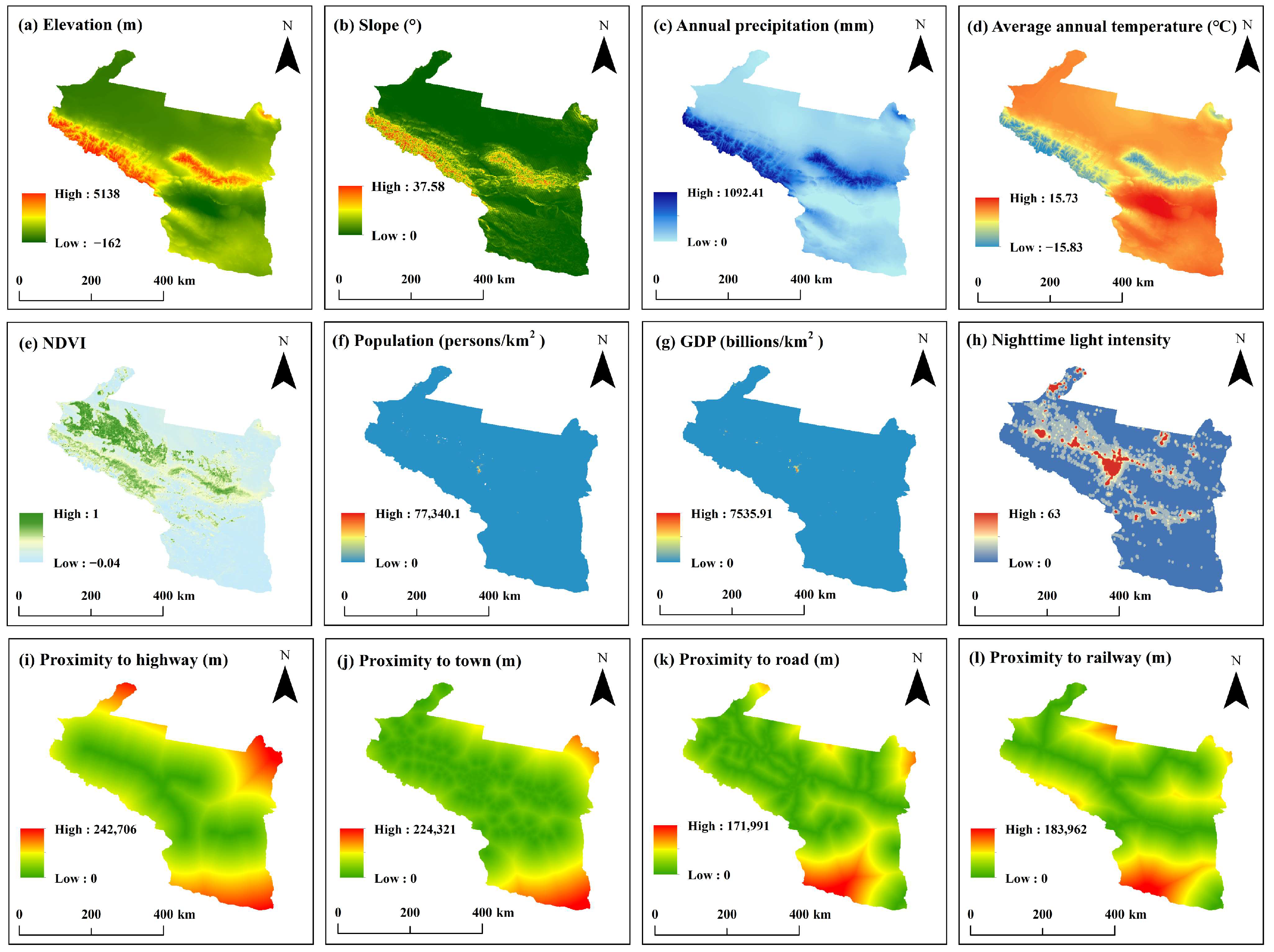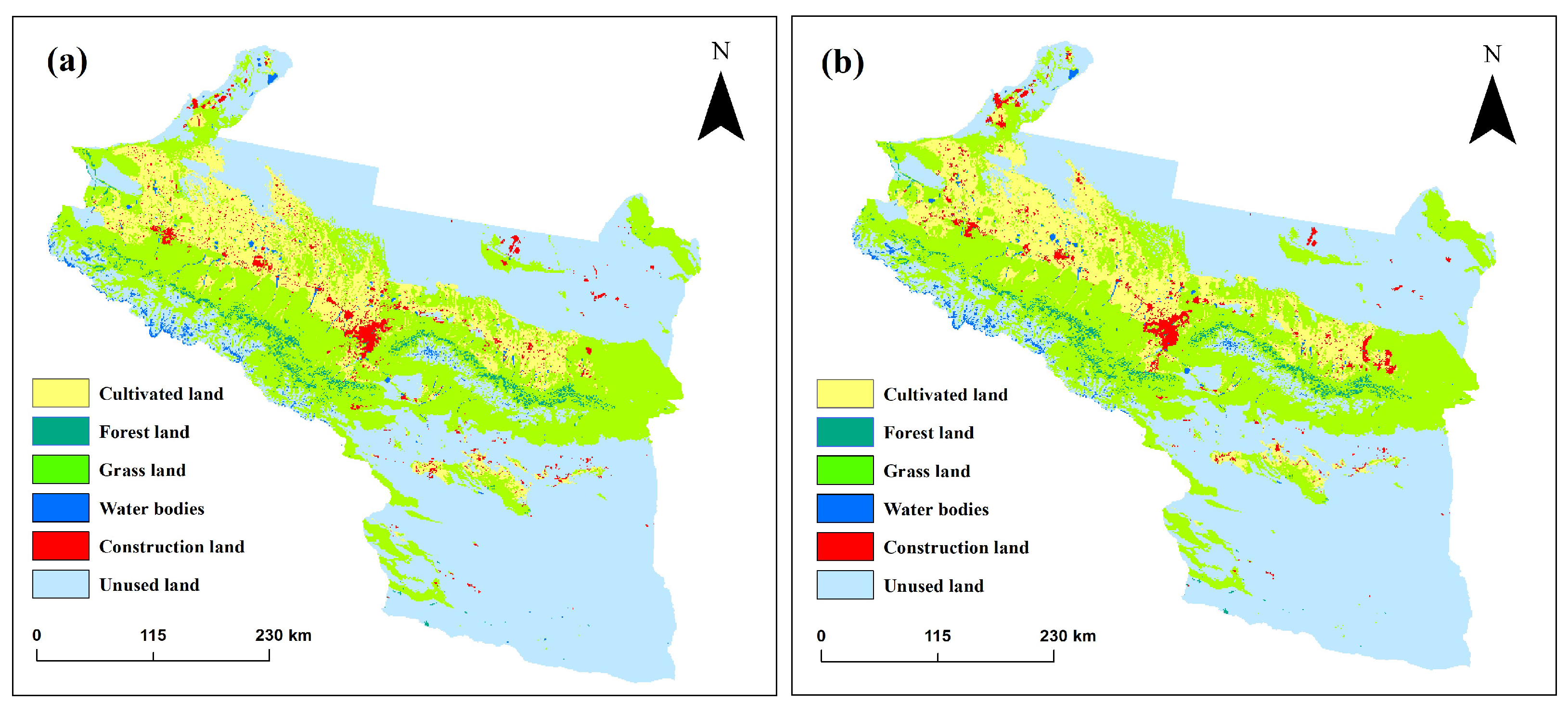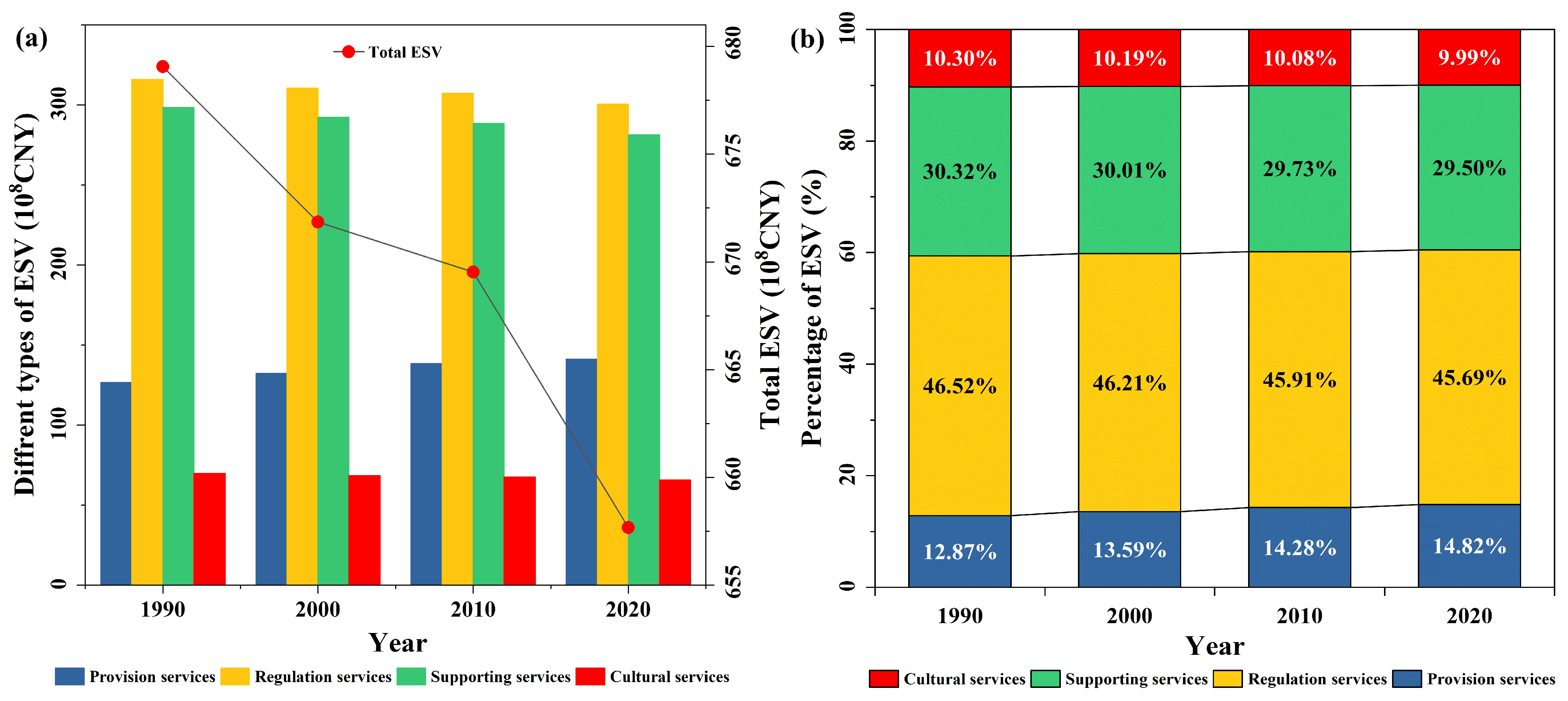From Land Use Change to Ecosystem Service Sustainability: Multi-Scenario Projections for Urban Agglomerations in Arid Northwest China
Abstract
1. Introduction
2. Materials and Methods
2.1. Study Region
2.2. Data Source and Processing
2.3. FLUS Model
2.4. Selection of the Driving Factors
2.5. Scenario Development
2.6. Validation of FLUS Model
2.7. Assessment of ESV
2.8. Spatial Autocorrelation Analysis
3. Results
3.1. LULC Change Analysis and Simulation Under Multiple Scenarios
3.2. Spatial-Temporal Changes in ESV
3.3. Spatial Aggregation of ESV
3.4. Spatial Cold and Hot Spot Patterns of ESV
3.5. ESV Analysis Under Multi-Scenarios
4. Discussion
4.1. Changes in LULC and ESV in UANSTM
4.2. From Patterns to Practice: Conservation Implications and Policy Recommendations of ESV Cold and Hot Spots
4.3. Limitations and Future Work
5. Conclusions
Author Contributions
Funding
Data Availability Statement
Acknowledgments
Conflicts of Interest
Abbreviations
| ESV | Ecosystem Service Value |
| FLUS | Future Land Use Simulation |
| UANSTM | Urban Agglomeration on the Northern Slope of the Tianshan Mountains |
| NDS | Natural Development Scenario |
| CLPS | Cultivated Land Protection Scenario |
| EPS | Ecological Protection Scenario |
| LULC | Land Use and Land Cover |
| CLUE-S | Conversion of Land Use and its Effects at Small regional extent |
| PLUS | Patch-generating Land Use Simulation |
| LCM | Land Change Modeler |
| DEM | Digital Elevation Model |
| NDVI | Normalized Difference Vegetation Index |
| GDP | Gross Domestic Product |
| NTL | Nighttime Light |
| CA | Cellular Automata |
| ANN | Artificial Neural Network |
References
- Seto, K.; Güneralp, B.; Hutyra, L. Global forecasts of urban expansion to 2030 and direct impacts on biodiversity and carbon pools. Proc. Natl. Acad. Sci. USA 2012, 109, 16083–16088. [Google Scholar] [CrossRef] [PubMed]
- Polydoros, A.; Cartalis, C. Assessing the impact of urban expansion to the state of thermal environment of peri-urban areas using indices. Urban Clim. 2015, 14, 166–175. [Google Scholar] [CrossRef]
- Xiao, R.; Lin, M.; Fei, X.; Li, Y.; Zhang, Z.; Meng, Q. Exploring the interactive coercing relationship between urbanization and ecosystem service value in the Shanghai–Hangzhou Bay Metropolitan Region. J. Clean. Prod. 2020, 253, 119803. [Google Scholar] [CrossRef]
- Watson, R.T.; Scientist, C.; Bank, W.; Arico, S.; Bridgewater, P.; Tschirley, J.; Valentini, R.; Almeida, F.; Barnard, P.; Invasive, G. Ecosystems and Human Well Being; Millenium Ecosystem Assessment; World Resources Institute: Washington, DC, USA, 2005. [Google Scholar]
- Shifaw, E.; Sha, J.; Li, X.; Bao, Z.; Zhou, Z. An insight into land-cover changes and their impacts on ecosystem services before and after the implementation of a comprehensive experimental zone plan in Pingtan island, China. Land Use Policy 2019, 82, 631–642. [Google Scholar] [CrossRef]
- Verburg, P.H.; Neumann, K.; Nol, L. Challenges in using land use and land cover data for global change studies. Glob. Change Biol. 2011, 17, 974–989. [Google Scholar] [CrossRef]
- Costanza, R.; d’Arge, R.; de Groot, R.; Farber, S.; Grasso, M.; Hannon, B.; Limburg, K.; Naeem, S.; O’Neill, R.V.; Paruelo, J.; et al. The value of the world’s ecosystem services and natural capital. Nature 1997, 387, 253–260. [Google Scholar] [CrossRef]
- Xie, G.; Zhang, C.; Zhen, L.; Zhang, L. Dynamic changes in the value of China’s ecosystem services. Ecosyst. Serv. 2017, 26, 146–154. [Google Scholar] [CrossRef]
- Liu, S.; Costanza, R.; Farber, S.; Troy, A. Valuing Ecosystem Services: Theory, Practice, and the Need for a Transdisciplinary Synthesis; Wiley/Blackwell: Hoboken, NJ, USA, 2010. [Google Scholar]
- Kang, Z.; Ling, H.; Gong, Y.; Yan, J.; Han, F.; Shan, Q.; Zhang, G. The precise implementation of the ecological water transfer project effectively promotes the enhancement of desert riparian ecosystem service value in the mainstream of Tarim River. Ecol. Indic. 2024, 169, 112914. [Google Scholar] [CrossRef]
- Jiang, W.; Wu, T.; Fu, B. The value of ecosystem services in China: A systematic review for twenty years. Ecosyst. Serv. 2021, 52, 101365. [Google Scholar] [CrossRef]
- Kang, N.; Hou, L.; Huang, J.; Liu, H. Ecosystem services valuation in China: A meta-analysis. Sci. Total Environ. 2022, 809, 151122. [Google Scholar] [CrossRef] [PubMed]
- Yang, P.; Alifujiang, Y.; Jiang, Y.; Feng, J. Study on the evaluation of ecosystem service values of typical lakes in Xinjiang. J. Nat. Conserv. 2025, 86, 126906. [Google Scholar] [CrossRef]
- Xie, G.D.; Zhang, C.X.; Zhang, L.M.; Chen, W.H.; Li, S.M. Improvement of the Evaluation Method for Ecosystem Service Value Based on Per Unit Area. J. Nat. Resour. 2015, 30, 1243–1254. [Google Scholar]
- Britz, W.; Verburg, P.H.; Leip, A. Modelling of land cover and agricultural change in Europe: Combining the CLUE and CAPRI-Spat approaches. Agric. Ecosyst. Environ. 2011, 142, 40–50. [Google Scholar] [CrossRef]
- Samie, A.; Deng, X.; Jia, S.; Chen, D. Scenario-Based Simulation on Dynamics of Land-Use-Land-Cover Change in Punjab Province, Pakistan. Sustainability 2017, 9, 1285. [Google Scholar] [CrossRef]
- Veldkamp, A.; Lambin, E.F. Predicting land-use change. Agric. Ecosyst. Environ. 2001, 85, 1–6. [Google Scholar] [CrossRef]
- Loukika, K.N.; Keesara, V.R.; Buri, E.S.; Sridhar, V. Future prediction of scenario based land use land cover (LU&LC) using DynaCLUE model for a river basin. Ecol. Inform. 2023, 77, 102223. [Google Scholar] [CrossRef]
- De Rosa, M.; Knudsen, M.T.; Hermansen, J.E. A comparison of Land Use Change models: Challenges and future developments. J. Clean. Prod. 2016, 113, 183–193. [Google Scholar] [CrossRef]
- Shuai, Q.; Xue, J.; Dai, L.; Huang, Y.; Jin, D.; Chen, Z.; Li, M.; Shi, Z.; Chen, S. The effects of land use change on soil organic carbon stock in China: A meta-analysis with the empirical modeling approach. Geoderma Reg. 2024, 36, e00774. [Google Scholar] [CrossRef]
- Liang, Z.; Liang, X.; Jiang, X.; Li, T.; Guan, Q. Balancing simulation performance and computational intensity of CA models for large-scale land-use change simulations. Environ. Model. Softw. 2025, 185, 106293. [Google Scholar] [CrossRef]
- Duan, X.; Haseeb, M.; Tahir, Z.; Mahmood, S.A.; Tariq, A. Analyzing and predicting land use and land cover dynamics using multispectral high-resolution imagery and hybrid CA-Markov modeling. Land Use Policy 2025, 157, 107655. [Google Scholar] [CrossRef]
- Li, S.-H.; Lin, W. A hybrid landscape metric-enhanced cellular automata model (LE-CA) for land use/land cover change simulation: An application to coastal wetlands. Ecol. Model. 2025, 508, 111209. [Google Scholar] [CrossRef]
- Molinero-Parejo, R.; Aguilera-Benavente, F.; Gómez-Delgado, M.; Shurupov, N. Combining a land parcel cellular automata (LP-CA) model with participatory approaches in the simulation of disruptive future scenarios of urban land use change. Comput. Environ. Urban Syst. 2023, 99, 101895. [Google Scholar] [CrossRef]
- Kiziridis, D.A.; Mastrogianni, A.; Pleniou, M.; Tsiftsis, S.; Xystrakis, F.; Tsiripidis, I. Improving the predictive performance of CLUE-S by extending demand to land transitions: The trans-CLUE-S model. Ecol. Model. 2023, 478, 110307. [Google Scholar] [CrossRef]
- Liao, G.; He, P.; Gao, X.; Lin, Z.; Huang, C.; Zhou, W.; Deng, O.; Xu, C.; Deng, L. Land use optimization of rural production–living–ecological space at different scales based on the BP–ANN and CLUE–S models. Ecol. Indic. 2022, 137, 108710. [Google Scholar] [CrossRef]
- Luo, G.; Yin, C.; Chen, X.; Xu, W.; Lu, L. Combining system dynamic model and CLUE-S model to improve land use scenario analyses at regional scale: A case study of Sangong watershed in Xinjiang, China. Ecol. Complex. 2010, 7, 198–207. [Google Scholar] [CrossRef]
- Liu, J.; Kong, X.; Zhu, Y.; Zhang, B. A study on land use change simulation based on PLUS model and the U-net structure: A case study of Jilin Province. Ecol. Indic. 2025, 176, 113619. [Google Scholar] [CrossRef]
- Gao, X.; Hu, Y.; Zhang, Z.; Jiao, Y.; Ji, W.; Qian, Y.; He, Y.; Pei, L.; Yin, Y.; Hu, Y.; et al. Analysis of the spatiotemporal evolution of cultivated land in the Chaohu Basin based on the PLUS model and multi-scenario simulation. Sustain. Futures 2025, 10, 100945. [Google Scholar] [CrossRef]
- Zhu, Z.; Zhao, S.; Li, Q.; Shi, Z.; Wu, Y.; Wang, L. Spatiotemporal evolution and prediction of land use change and carbon storage in ionic rare earth mining areas based on the YOLOv11–SegFormer–InVEST–PLUS integrated model. Ecol. Indic. 2025, 178, 113983. [Google Scholar] [CrossRef]
- Huang, M.; Mamitimin, Y.; Abulizi, A.; Yimaer, R.; Tiemuerbieke, B.; Chen, H.; Tao, T.; Ma, Y. Integrated assessment of land use and carbon storage changes in the Tulufan-Hami Basin under the background of urbanization and climate change. Int. J. Appl. Earth Obs. Geoinf. 2024, 135, 104261. [Google Scholar] [CrossRef]
- Mamitimin, Y.; Simayi, Z.; Mamat, A.; Maimaiti, B.; Ma, Y. FLUS Based Modeling of the Urban LULC in Arid and Semi-Arid Region of Northwest China: A Case Study of Urumqi City. Sustainability 2023, 15, 4912. [Google Scholar] [CrossRef]
- Liu, P.; Hu, Y.; Jia, W. Land use optimization research based on FLUS model and ecosystem services–setting Jinan City as an example. Urban Clim. 2021, 40, 100984. [Google Scholar] [CrossRef]
- Mumtaz, F.; Li, J.; Liu, Q.; Arshad, A.; Dong, Y.; Liu, C.; Zhao, J.; Bashir, B.; Gu, C.; Wang, X.; et al. Spatio-temporal dynamics of land use transitions associated with human activities over Eurasian Steppe: Evidence from improved residual analysis. Sci. Total Environ. 2023, 905, 166940. [Google Scholar] [CrossRef]
- Chen, J.; Kasimu, A.; Tang, L.; Han, F.; Jumai, M. Ecosystem service trade-offs and synergies based on the mechanical equilibrium model: A case study of the urban agglomeration on the northern slope of the Tianshan Mountains. Ecol. Indic. 2025, 177, 113795. [Google Scholar] [CrossRef]
- Song, X.; Chen, F.; Sun, Y.; Ma, J.; Yang, Y.; Shi, G. Effects of land utilization transformation on ecosystem services in urban agglomeration on the northern slope of the Tianshan Mountains, China. Ecol. Indic. 2024, 162, 112046. [Google Scholar] [CrossRef]
- Yu, T.; Abulizi, A.; Xu, Z.; Jiang, J.; Akbar, A.; Ou, B.; Xu, F. Evolution of environmental quality and its response to human disturbances of the urban agglomeration in the northern slope of the Tianshan Mountains. Ecol. Indic. 2023, 153, 110481. [Google Scholar] [CrossRef]
- Liu, X.; Liang, X.; Li, X.; Xu, X.; Ou, J.; Chen, Y.; Li, S.; Wang, S.; Pei, F. A future land use simulation model (FLUS) for simulating multiple land use scenarios by coupling human and natural effects. Landsc. Urban Plan. 2017, 168, 94–116. [Google Scholar] [CrossRef]
- Zhu, M.; Yu, X.; Chen, K.; Tan, H.; Yuan, J. Spatiotemporal characteristics and driving factors of chemical oxygen demand emissions in China’s wastewater: An analysis based on spatial autocorrelation and geodetector. Ecol. Indic. 2024, 166, 112308. [Google Scholar] [CrossRef]
- Lanorte, A.; Danese, M.; Lasaponara, R.; Murgante, B. Multiscale mapping of burn area and severity using multisensor satellite data and spatial autocorrelation analysis. Int. J. Appl. Earth Obs. Geoinf. 2013, 20, 42–51. [Google Scholar] [CrossRef]
- Cheng, X.; Chen, L.; Sun, R.; Kong, P. Land use changes and socio-economic development strongly deteriorate river ecosystem health in one of the largest basins in China. Sci. Total Environ. 2018, 616–617, 376–385. [Google Scholar] [CrossRef]
- Abulizi, A.; Yang, Y.; Mamat, Z.; Luo, J.; Abdulslam, D.; Xu, Z.; Zayiti, A.; Ahat, A.; Halik, W. Land-Use Change and its Effects in Charchan Oasis, Xinjiang, China. Land Degrad. Dev. 2017, 28, 106–115. [Google Scholar] [CrossRef]
- Muyibul, Z.; Jianxin, X.; Muhtar, P.; Qingdong, S.; Run, Z. Spatiotemporal changes of land use/cover from 1995 to 2015 in an oasis in the middle reaches of the Keriya River, southern Tarim Basin, Northwest China. Catena 2018, 171, 416–425. [Google Scholar] [CrossRef]
- Wang, S.; Wu, B.; Yang, P. Assessing the changes in land use and ecosystem services in an oasis agricultural region of Yanqi Basin, Northwest China. Environ. Monit. Assess. 2014, 186, 8343–8357. [Google Scholar] [CrossRef] [PubMed]
- Arowolo, A.O.; Deng, X.; Olatunji, O.A.; Obayelu, A.E. Assessing changes in the value of ecosystem services in response to land-use/land-cover dynamics in Nigeria. Sci. Total Environ. 2018, 636, 597–609. [Google Scholar] [CrossRef] [PubMed]
- Disse, M. Sustainable land and water management of River Oases along the Tarim River. In Proceedings of the International Water Resources Management Conference of ICWRS, Prague, Czech Republic, 18–20 July 2017. [Google Scholar]
- Zhang, Z.; Xia, F.; Yang, D.; Huo, J.; Wang, G.; Chen, H. Spatiotemporal characteristics in ecosystem service value and its interaction with human activities in Xinjiang, China. Ecol. Indic. 2020, 110, 105826. [Google Scholar] [CrossRef]
- Li, X.; Wu, C. Sensitivity assessment and simulation of ecosystem services in response to land use change in arid regions: Empirical evidence from Xinjiang, China. Ecol. Indic. 2025, 171, 113150. [Google Scholar] [CrossRef]
- Xu, C.; Jiang, W.; Huang, Q.; Wang, Y. Ecosystem services response to rural-urban transitions in coastal and island cities: A comparison between Shenzhen and Hong Kong, China. J. Clean. Prod. 2020, 260, 121033. [Google Scholar] [CrossRef]











| Data Categories | Data Name | Data Sources | Spatial Resolution |
|---|---|---|---|
| Terrain and land use | Land use data | Resource and Environment Science and Data Center, Chinese Academy of Sciences (https://www.resdc.cn/) | 30 m |
| DEM | Geospatial Data Cloud site, Computer Network Information Center, Chinese Academy of Sciences (https://www.gscloud.cn/) | 30 m | |
| Slope | Computational generation | 30 m | |
| Bioclimatic variables | Average annual precipitation | National Centers for Environmental Information (https://www.ncei.noaa.gov/) | 1 km |
| Average annual temperature | 1 km | ||
| NDVI | Resource and Environment Science and Data Center, Chinese Academy of Sciences (https://www.resdc.cn/) | 1 km | |
| Socioeconomic metrics | Population | Resource and Environment Science and Data Center, Chinese Academy of Sciences (https://www.resdc.cn/) | 1 km |
| GDP | 1 km | ||
| NTL | 500 m | ||
| Crop planting area and total production data | Statistical Yearbook of Xinjiang, China | - | |
| Infrastructure networks | Transportation network data and human settlement distribution | National Geographic Information Public Service Platform (https://www.tianditu.gov.cn/) | - |
| Scenario | NDS | CLPS | EPS | |||||||||||||||
|---|---|---|---|---|---|---|---|---|---|---|---|---|---|---|---|---|---|---|
| Cu | Fo | Gr | Wa | Co | Un | Cu | Fo | Gr | Wa | Co | Un | Cu | Fo | Gr | Wa | Co | Un | |
| Cu | 1 | 1 | 1 | 0 | 1 | 0 | 1 | 0 | 0 | 0 | 0 | 0 | 1 | 1 | 1 | 0 | 1 | 0 |
| Fo | 1 | 1 | 1 | 0 | 1 | 0 | 1 | 1 | 1 | 0 | 1 | 0 | 0 | 1 | 0 | 0 | 0 | 0 |
| Gr | 1 | 1 | 1 | 0 | 1 | 0 | 1 | 1 | 1 | 0 | 1 | 0 | 0 | 1 | 1 | 1 | 0 | 0 |
| Wa | 0 | 0 | 0 | 1 | 0 | 0 | 0 | 0 | 0 | 1 | 0 | 0 | 0 | 0 | 0 | 1 | 0 | 0 |
| Co | 1 | 1 | 1 | 1 | 1 | 0 | 1 | 1 | 1 | 1 | 1 | 0 | 1 | 1 | 1 | 1 | 1 | 0 |
| Un | 1 | 1 | 1 | 1 | 1 | 1 | 1 | 1 | 1 | 1 | 1 | 1 | 1 | 1 | 1 | 1 | 1 | 1 |
| Land Use | Cultivated Land | Forest Land | Grass Land | Water Bodies | Construction Land | Unused Land |
|---|---|---|---|---|---|---|
| Cultivated land | 2000 | 1 | 144 | 2 | 72 | 5 |
| Forest land | 1 | 270 | 0 | 0 | 0 | 0 |
| Grass land | 166 | 1 | 5606 | 9 | 44 | 33 |
| Water bodies | 2 | 0 | 4 | 182 | 1 | 2 |
| Construction land | 36 | 0 | 96 | 0 | 201 | 3 |
| Unused land | 5 | 0 | 14 | 4 | 34 | 10,460 |
| Producer’s Accuracy | 0.90 | 0.99 | 0.96 | 0.92 | 0.57 | 1.00 |
| User’s Accuracy | 0.90 | 1.00 | 0.96 | 0.95 | 0.60 | 0.99 |
| Kappa Coefficient: 0.94, Overall Accuracy: 0.97 | ||||||
| Land Use | 1990 | 2000 | 2010 | 2020 | △1990–2020 | |||||
|---|---|---|---|---|---|---|---|---|---|---|
| Area (km2) | Percentage (%) | Area (km2) | Percentage (%) | Area (km2) | Percentage (%) | Area (km2) | Percentage (%) | km2 | % | |
| Cultivated land | 17,721 | 9.14 | 19,524 | 10.06 | 21,407 | 11.04 | 22,538 | 11.62 | 4817 | 27.18 |
| Forest land | 2900 | 1.49 | 2641 | 1.36 | 2602 | 1.34 | 2596 | 1.34 | −304 | −10.48 |
| Grassland | 63,502 | 32.74 | 62,065 | 32.00 | 60,914 | 31.40 | 59,027 | 30.43 | −4475 | −7.05 |
| Water bodies | 1639 | 0.84 | 1749 | 0.90 | 1777 | 0.92 | 1741 | 0.90 | 102 | 6.22 |
| Construction land | 1926 | 0.99 | 2133 | 1.10 | 2287 | 1.18 | 3388 | 1.75 | 1462 | 75.91 |
| Unused land | 106,292 | 54.80 | 105,868 | 54.58 | 104,993 | 54.13 | 104,690 | 53.97 | −1602 | −1.51 |
| Land Use | Area of Land Use in 2030 (km2) | △2020–2030 (km2 and %) | |||||||
|---|---|---|---|---|---|---|---|---|---|
| NDS | CLPS | EPS | NDS | % | CLPS | % | EPS | % | |
| Cultivated land | 23,581 | 23,583 | 22,086 | 1043 | 4.63 | 1045 | 4.64 | −452 | −2.01 |
| Forest land | 2590 | 2590 | 2855 | −6 | −0.23 | −6 | −0.23 | 259 | 9.98 |
| Grassland | 57,225 | 57,225 | 59,107 | −1802 | −3.05 | −1802 | −3.05 | 80 | 0.14 |
| Water bodies | 1706 | 1771 | 1792 | −35 | −2.01 | 30 | 1.72 | 51 | 2.93 |
| Construction land | 4491 | 4424 | 3753 | 1103 | 32.56 | 1036 | 30.58 | 365 | 10.77 |
| Unused land | 104,387 | 104,387 | 104,387 | −303 | −0.29 | −303 | −0.29 | −303 | −0.29 |
| Year | Moran’s I | Z Scores | p Value |
|---|---|---|---|
| 1990 | 0.691 | 1146.2105 | 0.001 |
| 2000 | 0.6967 | 1175.4911 | 0.001 |
| 2010 | 0.700 | 1167.6374 | 0.001 |
| 2020 | 0.6933 | 1153.3285 | 0.001 |
| Year | Cold Spot-99% Confidence (Area, km2) | % | Cold Spot-95% Confidence (Area, km2) | % | Cold Spot-90% Confidence (Area, km2) | % | Hot Spot—90% Confidence (Area, km2) | % | Hot Spot—95% Confidence (Area, km2) | % | Hot Spot—99% Confidence (Area, km2) | % |
|---|---|---|---|---|---|---|---|---|---|---|---|---|
| 1990 | 89,730 | 24.97 | 3388 | 25.16 | 1810 | 26.81 | 2565 | 21.44 | 5816 | 24.54 | 65,029 | 25.84 |
| 2000 | 89,990 | 25.04 | 3413 | 25.35 | 1623 | 24.04 | 2812 | 23.51 | 6177 | 26.06 | 63,500 | 25.24 |
| 2010 | 89,815 | 24.99 | 3296 | 24.48 | 1587 | 23.51 | 3143 | 26.28 | 6135 | 25.88 | 62,420 | 24.81 |
| 2020 | 89,847 | 25.00 | 3369 | 25.02 | 1730 | 25.63 | 3441 | 28.77 | 5574 | 23.52 | 60,683 | 24.12 |
| ESV | ESV in 2030 (108 CNY) | ESV Change in 2020–2030 (108 CNY) | ||||
|---|---|---|---|---|---|---|
| NDS | CLPS | EPS | NDS | CLPS | EPS | |
| PS | 99.14 | 99.26 | 96.66 | 1.68 | 1.80 | −0.80 |
| RS | 293.81 | 294.41 | 303.12 | −6.66 | −6.06 | 2.65 |
| SS | 189.26 | 189.61 | 195.86 | −4.78 | −4.43 | 1.82 |
| CS | 63.97 | 64.20 | 66.55 | −1.72 | −1.49 | 0.86 |
| Total | 646.18 | 647.49 | 662.20 | −11.49 | −10.18 | 4.53 |
Disclaimer/Publisher’s Note: The statements, opinions and data contained in all publications are solely those of the individual author(s) and contributor(s) and not of MDPI and/or the editor(s). MDPI and/or the editor(s) disclaim responsibility for any injury to people or property resulting from any ideas, methods, instructions or products referred to in the content. |
© 2025 by the authors. Licensee MDPI, Basel, Switzerland. This article is an open access article distributed under the terms and conditions of the Creative Commons Attribution (CC BY) license (https://creativecommons.org/licenses/by/4.0/).
Share and Cite
Mamitimin, Y.; Nuerla, A.; Abudushalamu, Z.; Huang, M. From Land Use Change to Ecosystem Service Sustainability: Multi-Scenario Projections for Urban Agglomerations in Arid Northwest China. Urban Sci. 2025, 9, 433. https://doi.org/10.3390/urbansci9100433
Mamitimin Y, Nuerla A, Abudushalamu Z, Huang M. From Land Use Change to Ecosystem Service Sustainability: Multi-Scenario Projections for Urban Agglomerations in Arid Northwest China. Urban Science. 2025; 9(10):433. https://doi.org/10.3390/urbansci9100433
Chicago/Turabian StyleMamitimin, Yusuyunjiang, Ailijiang Nuerla, Zaimire Abudushalamu, and Meiling Huang. 2025. "From Land Use Change to Ecosystem Service Sustainability: Multi-Scenario Projections for Urban Agglomerations in Arid Northwest China" Urban Science 9, no. 10: 433. https://doi.org/10.3390/urbansci9100433
APA StyleMamitimin, Y., Nuerla, A., Abudushalamu, Z., & Huang, M. (2025). From Land Use Change to Ecosystem Service Sustainability: Multi-Scenario Projections for Urban Agglomerations in Arid Northwest China. Urban Science, 9(10), 433. https://doi.org/10.3390/urbansci9100433






